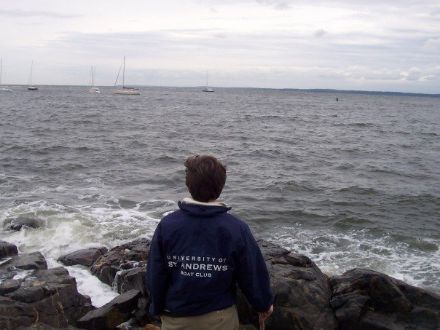World
About Andrew Cusack
 Writer, web designer, etc.; born in New York; educated in Argentina, Scotland, and South Africa; now based in London.
Writer, web designer, etc.; born in New York; educated in Argentina, Scotland, and South Africa; now based in London. read more
News
Blogs
Reviews & Periodicals
Arts & Design
World
France
Mitteleuropa
Knickerbockers
Argentina
The Levant
Africa
Cape of Good Hope
Netherlands
Scandinavia
Québec
India
Muscovy
Germany
Academica
The Prince of Wales in Philadelphia
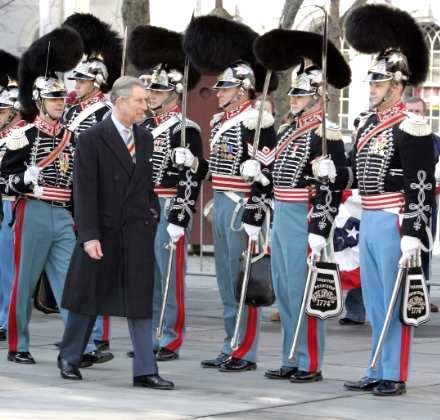
THE CITY OF PHILADELPHIA welcomed the Prince of Wales on his recent visit with a guard of honor composed of members of its most ancient military unit, the First Troop, Philadelphia City Cavalry. Organized in 1774 as the Light Horse of the City of Philadelphia, it describes itself as the “oldest continuously active military unit in service to the nation”. As an active armored cavalry troop, it forms part of the 28th Division, while as an historic and ceremonial unit it is a component of the Centennial Legion (of which my grandfather served as commander). Since the most unfortunate demise of New York’s Seventh Regiment, it probably takes the prize for swankiest unit in the States.
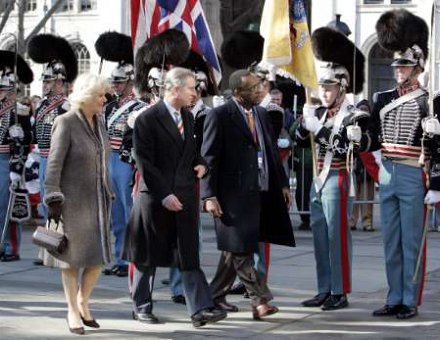
Previously: Old Dominion Will Receive Her Majesty | The Duke of York in New York | Your Royal Highness, Caed Mile Failte
A Sienese Gem Lost
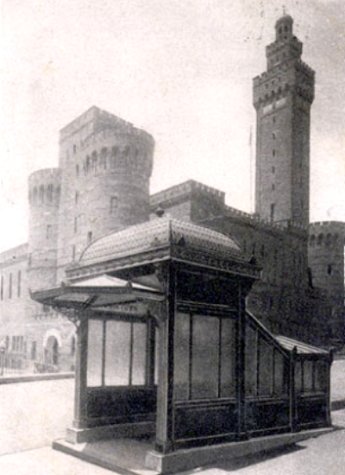
STEALING A GLANCE at the photo above, the viewer would easily be forgiven for mistaking the vista for that of a subway entrance in turn-of-the-century Siena, Italy. The proud medieval tower lurks over a comely metal-and-glass structure of continental flavor. However the city fathers of that ancient Italian municipality never deigned to erect an underground railway. The precise locus of the vista is far removed: it is the corner of Park Avenue and 33rd Street, and the building behind the subway entrance is not the town hall of Siena, but rather the armory of the 71st Regiment, New York National Guard.
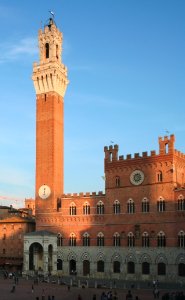 When the earlier Romanesque Revival armory of the Seventy-First Regiment burnt down in 1902, it was decided to build the new armory on the same, though slightly enlarged, site. The 1905 construction was built to the design of the architectural firm of Clinton and Russell, and was clearly inspired by the Palazzo Pubblico (the town hall, photo at right) of Siena, on that city’s Piazza de Campo. While the Seventh Regiment Armory contains the finest interiors of any military building in City, and probably the entire Empire State, the exterior of the Seventy-First’s armory was far superior. Even though the interior was not to the same lofty standard as the Seventh, it was by no means lacking, for it had all the wood-panelled rooms filled with military regalia from times gone by which one expects of New York’s armories from the period. (more…)
When the earlier Romanesque Revival armory of the Seventy-First Regiment burnt down in 1902, it was decided to build the new armory on the same, though slightly enlarged, site. The 1905 construction was built to the design of the architectural firm of Clinton and Russell, and was clearly inspired by the Palazzo Pubblico (the town hall, photo at right) of Siena, on that city’s Piazza de Campo. While the Seventh Regiment Armory contains the finest interiors of any military building in City, and probably the entire Empire State, the exterior of the Seventy-First’s armory was far superior. Even though the interior was not to the same lofty standard as the Seventh, it was by no means lacking, for it had all the wood-panelled rooms filled with military regalia from times gone by which one expects of New York’s armories from the period. (more…)
The Still Solid Spectator
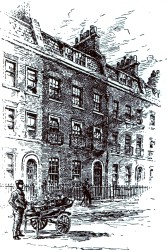 WHEN MATTHEW D’ANCONA took the helm as editor at the Spectator, worry surfaced. I had heard that he was something of a Blairite (though that is the trend amongst Tory bigwigs these days) and those worries were not allayed by the loathsome interjection in the beloved weekly of a ‘business’ section and the ambiguous ‘style and travel’ segment. These were most unwelcome changes; what would the late great Peter Simple have made of them? Nonetheless, the quality outwith those interlopers has not declined significantly, and despite the sad pleas of the Israeli ambassador, the ever-amusing Poor Little Greek Boy has not been given the boot.
WHEN MATTHEW D’ANCONA took the helm as editor at the Spectator, worry surfaced. I had heard that he was something of a Blairite (though that is the trend amongst Tory bigwigs these days) and those worries were not allayed by the loathsome interjection in the beloved weekly of a ‘business’ section and the ambiguous ‘style and travel’ segment. These were most unwelcome changes; what would the late great Peter Simple have made of them? Nonetheless, the quality outwith those interlopers has not declined significantly, and despite the sad pleas of the Israeli ambassador, the ever-amusing Poor Little Greek Boy has not been given the boot.
Nonetheless, the hopefully brief reign of that slatternly goddess Change is not yet finished, for the Spectator is moving from their legendary offices at No. 56 Doughty Street. The office, a few doors down from the home of Charles Dickens, has become reknowned for its lunches. When the Prince of Wales was invited, he specifically asked for the Poor Little Greek Boy and Jeff Barnard, but editor Charles Moore (a convert to Catholicism) declined the request. “Why not?” inquired H.R.H. “Because,” quoth Moore, “Jeff will use the F-word non-stop and the Greek boy will leak to the tabloids”. But, as Taki tells us in this week’s issue,
Doughty Street was home to the weekly for over three decades, before which it was edited from No. 99 Gower Street in Bloomsbury.
While the venerable Speccie is leaving a splendid, old building, thankfully it will not be emigrating to the dreary modernity of Canary Wharf but rather to 22 Old Queen Street in Westminster. “It’s a magnificent Georgian building, much bigger than the present one, with a beautiful garden,” d’Ancona told the Evening Standard. The garden happens to look out onto St. James Park, and so should prove quite adequate to hosting the Spectator‘s annual garden party.
Previously: Welcome to Doughty Street
King Jagiello of Poland
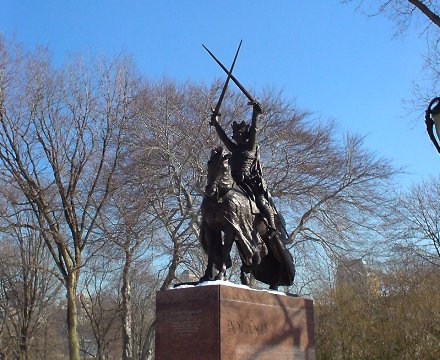
My favorite statue in Central Park is that of King Władysław II Jagiełło of Poland, by the Turtle Pond. (more…)
The Cardinal Duke of York
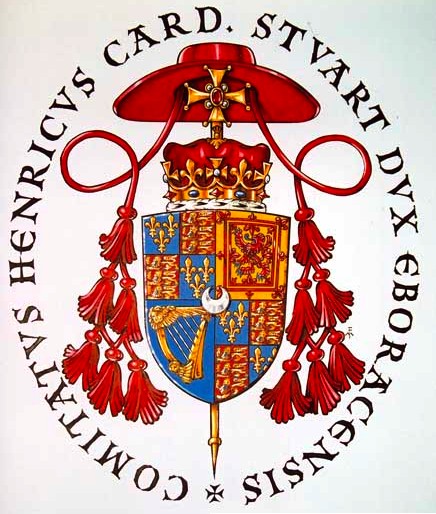
The great Marco Foppoli has designed (and very kindly passed along to me) the badge for the committee which has been assembled to commemorate the two-hundredth anniversary of the passing of the Cardinal Duke of York, or King Henry IX and I as was his style according to the Jacobite succession. I’m not entirely sure what events are being planned, but I believe there will be a conference in Rome around the anniversary in August.
The Greatest Building Never Built

LUTYENS’ SCHEME FOR the Metropolitan Cathedral of Christ the King, Liverpool is oft hailed as the greatest building to never have been built. Strictly speaking, this is not accurate, as the building was structurally finished, although not completely decorated, up to the crypt level. Nonetheless, had it been finished, the cathedral almost certainly would have been considered Sir Edwin Lutyens’ greatest work; though his hand (with Herbert Baker) in building the Indian capital of New Delhi, including the monumental Viceregal Palace, would certainly vie for the title. (more…)
A Morning’s Journey
I crossed the Harlem River into Manhattan today just as Patrick Leigh Fermor traversed the Danube in his brilliant book, A Time of Gifts, which has immediately become one of my favorite reads of all time. Settling into my seat on the train yesterday, I opened my knapsack to utter shock and surprise—I had left my reading at home. The Leigh Fermor and P.G.W.’s Cocktail Time were resting somewhere in my bedchamber while I stared into the compartment of my bag, bare but for a photocopied page from the Art Newspaper and two (already-read) issues of the Hungarian Quarterly. These are the times that try men’s souls. Getting out of the city late in the evening proved even harder, as the bridge carrying the railway over the river was actually up for once (“First time in my life, folks,” the conductor informed us), leaving a steady backlog of trains awaiting their northerly destinations.
But this morning there were no bridge-raising complications, and the sky was a delightful, clear blue (soon to change) as we entered Manhattan. Thankfully, I had my two books; a bit of Wodehouse while waiting in Bronxville station and then Paddy Leigh Fermor on the train. After crossing the river, the train stops at 125th Street (Harlem) before submerging at 96th, taking the passenger down to Grand Central, that well-kept remnant on 42nd Street, reminding us that we too were once civilized. There, after taking a stroll through the market (Nürnburger sausage! Kaiser ham! Norwegian salmon!) you switch to the subway and hop down just one express stop on the 5 train.
Just half a dozen steps after emerging from Union Square station I saw a speck of white fall from the sky, and then another, and another. So it began: the first snowfall of the year. And, I might add, a New York record for the latest snowfall. (January 10th? No, there was no white Christmas for us this year). Two children on the swings in the playground ecstatically proclaimed their approval at the opening of the heavens. Wandering through the farmer’s market in the square, I picked up an herb focaccia bread I thought might be particularly enjoyable, and it complimented the exceptionally tasty Tuscan vegetable soup I had for lunch. The snowflakes swirled above the square and fell down on all the market-goers and the folks walking on Broadway as I marched up to work. And yet, how fleeting! In the few steps from the front door to the elevator, the white snow had already melted and merged into the green of my loden coat. Very well, Mother Nature. Very well.
Argentina’s Henley
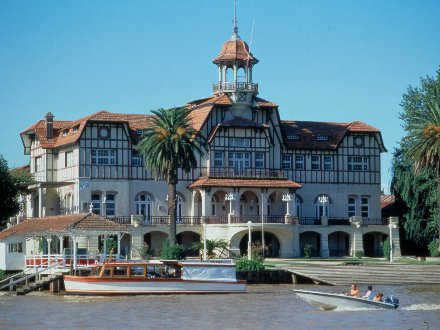
JUST NORTH OF Buenos Aires lies the city of Tigre. The city sits on the southern edge of the series of rivers, rivulets, islands, and eyots collectively known as the Parana Delta, after the Rio Parana which breaks up as it reachs the Rio de la Plata. The town’s riparian geography combined with its closeness to Buenos Aires—a mere twenty miles from the Obelisco—make Tigre a popular weekend and summertime getaway. Since the 1870s, however, it has also been the birthplace and focal point of rowing in the country—Argentina’s Henley. (more…)
Governors Island Revisited
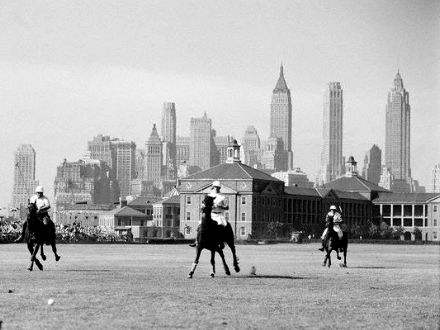
EVERY ONE OF THE myriad plans put forth for the ‘redevelopment’ of the venerable old Governors Island in New York Harbor has so far either stalled, been neglected, or otherwise poo-pooed. In this, we have something to rejoice. As I have often said, realistically speaking there is little that can be done to it which will not neglect or disgrace the island’s long military heritage. The officially-approved ideas put forth so far have been horrific: an amusement park, a casino, a ‘technology park’, as well as a number of other vapid proposals.
Naturally, we’d be enthused if it returned to its former role as swankiest post in the entire Army and the home of Army polo, but don’t hold your breath. West Point being the single exception, if it has even a touch of history, tradition, or class, Congress and the Department of Defense will do their best to get rid of it. After all, the National Guard has been pulled out of the Seventh Regiment Armory, the Navy has withdrawn all but a few institutions from Newport, and the Army has left the ancient Presidio of San Francisco; how long will it be until Fort Leavenworth’s foxhounds are brought out back and shot by the Monotony Monitors? (more…)
New York in November

A Gaggle of Bonapartes
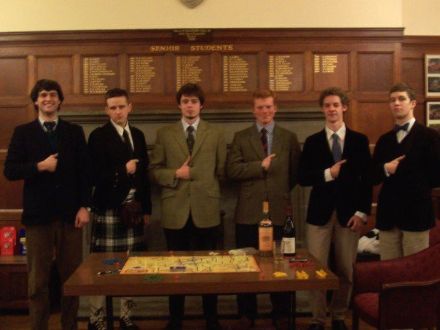
SOME OF MY best games of Risk were played during my St Andrews days: in Step Rock Cottage, in the A Squadron Mess, and a particularly enjoyable game in Canmore one evening when “Ishmael”, Stefano Costanzo, and I united our separate forces to defeat Abigail, whom we had summarily designated as a heathen ruler. (Once we had wiped her forces from the map of the world, we declared perpetual peace owing to our Christian brotherhood, and immediately adjourned to the Russell for a pint). I am glad, then, that the residents of my dear old St. Salvator’s Hall have initiated formal games of Risk. A good and wholesome pursuit, methinks. St Andrews is, according to those who know these things, the world’s foremost center for the study of “international relations” (the moniker by which the activity of correcting foreigners is known these days).
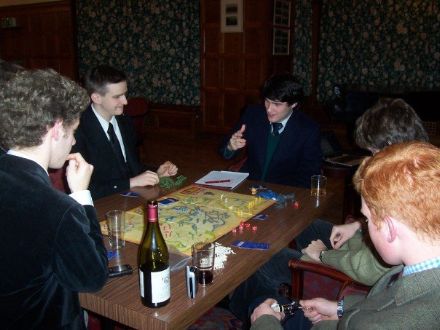
Herr Hoobler contributes a pithy remark about world domination.
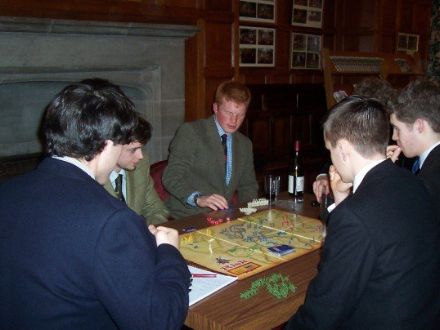
Paris Calling

Followers of worldy events in a technological fashion might be interested in viewing the world’s newest international news network, France 24. The English-language service, which can be viewed for free online, has so far proved more aesthetically pleasing than the American networks but seems a bit ‘light’ in terms of its content. Nonetheless, we will give it a year to flesh out before we hand down a final verdict.
Elsewhere: Wikipedia entry | France24: The Unofficial Weblog
Old Guard on Governors Island

A photo of the Old Guard of the City of New York on Governors Island, with Manhattan in the background, taken on St. George’s Day, 1933. [Click here for larger photo]
Previously: Evacuation Day | Marshal Foch and the Old Guard | A New York Funeral | Old Guardsmen | The Old Guard | Grandpa
Category: New York Militaria
An Evening at the Old Whitney
TO THE OLD Whitney Museum down on 8th Street, now home to the New York Studio School, which held a panel discussion to mark the twenty-fifth anniversary of the New Criterion. An interesting chat between Hilton Kramer, who left the New York Times to found the magazine in 1982, Karen Wilkin, one of our regular art critics, and James Panero, managing editor and art critic, all moderated by Michael J. Lewis of Williams College. The panel discussion covered myriad subjects related to art, from art criticism to the impossibility of an avant-garde in today’s culture of anything-goes to whether the New Criterion‘s ‘view’ of art can be considered part of any particular school of thought. Hilton had some particularly choice moments.
The building is a particularly nebulous one with many strange nooks and crannies, which can perhaps be explained by the fact that it is actually four townhouses gradually combined over a period of time. The Whitney Museum of American Art, of course, was founded in the 1930s by Gertrude Vanderbilt Whitney and was housed in these merged townhouses until moving to the specially-designed home at Madison and 75th in 1966 — widely agreed to be the ugliest building on the entire Upper East Side.
Among the nooks and crannies previously mentioned, Gertrude Vanderbilt Whitney’s former studio in the old mews building provided an excellent location for the dinner held afterwards, to which the participants, organizers, and a number of hangers-on (including yours truly) were invited. I sat between Gabbe, the New Criterion‘s former Editorial Assistant now working for the Studio School, and Joseph, an art student from outside Canterbury in Kent whose grandmother and grandfather both taught at the Studio School. Joseph and I discussed the beauty of the Somerset countryside, and I confessed I’d buy a cottage and move there in a second were it possible. The inimitable David Yezzi sat across the table and guided much of the conversation on our leg of the three tables, which had been arranged in a U-formation. A little later, I chatted with the artist seated to Gabbe’s left, who had been born in Latvia, with childhood spent in Baghdad, Italy, and England, before settling down in New York at the age of seven. We discussed the glories of Eastern Europe and the linguistic intricacies thereof. During dessert, however, I got on to architecture with the amiable Michael J. Lewis. I sung the praises of Audubon Terrace, one of my favorite spaces in all New York, which he (a Philadelphian) had only stumbled upon for the first time a month ago, and also of the nearby sculpted tomb of Bertram Grosvenor Goodhue, the greatest of all American architects.
Time waits for no man, however, and I managed to catch a late train back home from Grand Central. Alighting at Bronxville, I walked through the misty streets where the spherical streetlamps cast an eerie glow against the limestone façades of the shops. Home before midnight, and time for rest. Tommorrow, aside from being the feast of Saint Andrew, is Stefan Beck’s last day at the New Criterion. Needless to say, commemorative festivities are in order, and an alcoholic concoction known as ‘batch’ is to be brewed. It will not, I imagine, be for the faint of heart.
Elsewhere, the Austrian navy is no more.
Evacuation Day
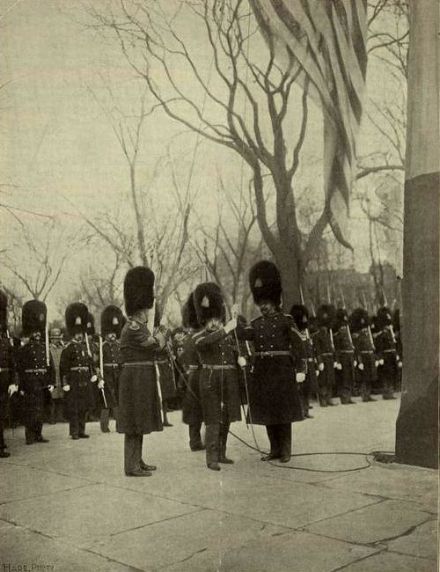
The Old Guard of the City of New York, raising the flag at the Battery on Evacuation Day, 1897. The day commemorates November 25, 1783, when the last royal troops left New York in accordance with the terms of the Treaty of Paris.
Old Dominion Will Receive Her Majesty
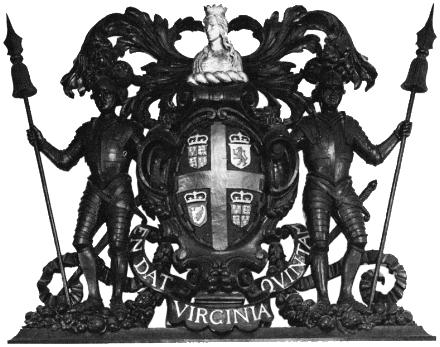
With these words spoken yesterday in the House of Lords, the Queen revealed the plans for her visit to the Commonwealth of Virginia for the upcoming celebrations surrounding the quatercentenary of the first permanent English settlement in the New World. Her Majesty is no stranger to Virginia, nor even to Jamestown, as her very first visit to the New World took place in 1957 when she attended the 350th anniversary celebrations at Jamestown. Following that 1957 official visit to the United States, the Queen opened her parliament at Ottawa for the first time since her accession to the Canadian throne. (more…)
Empire State Beauty
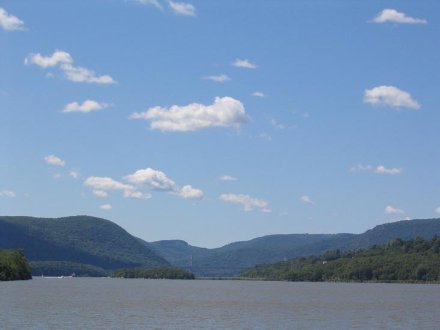
THE BRIDGE AND TUNNEL CLUB site often features photographs of myriad places, scenes, and things all around New York and beyond. Recently, the Bridge-and-Tunneller made a sojourn to various sites up the Hudson, and thankfully decided to share his photos. We bring you a selection of them, which you can find in their original form on the B&TC website. (more…)
The ‘Day of Fate’
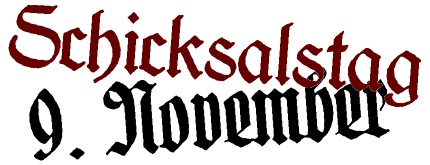
THE NINTH OF November is sometimes known in Germany as ‘Schicksalstag’ or the ‘Day of Fate’ owing to the series of events significant to modern German history which took place on the day in 1848, 1918, 1923, 1938, and 1989.
1918: Kaiser Wilhelm II is dethroned in the November Revolution, marking the end of the German monarchy.
1923: Hitler attempts his failed ‘Beer Hall Putsch’ which signficantly raises the profile of his tiny National Socialist German Workers’ Party.
1938: Synagogues and private property belonging to Jews are violently attacked in the ‘Kristallnacht’ pogrom.
1989: The politburo of Communist East Germany decides to relax the border-crossing restrictions between East and West Germany, leading to the fall of the Berlin Wall.
The first and last events (1848 and 1989) were encouraging events, while the three in between (1918, 1923, and 1938) were progressively worse. Indeed, it could easily be said that 1938 could not have happened without 1923, and that 1923 could not have happened without 1918, so these occurrences are not unrelated.
Children of a Common Mother
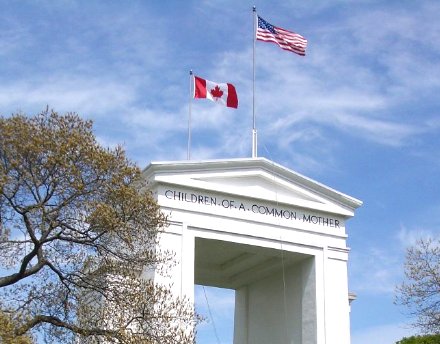
The 22-yard-tall Peace Arch stands between the city of Blaine in Washington state, and the city of Surrey in the province of British Columbia, demarcating the boundary between the United States of America and the Dominion of Canada. The monument, built in 1921, commemorates the 1814 Treaty of Ghent re-establishing peace between the United States and the British Empire.
Search
Instagram: @andcusack
Click here for my Instagram photos.Most Recent Posts
- Amsterdam November 26, 2024
- Silver Jubilee November 21, 2024
- Articles of Note: 11 November 2024 November 11, 2024
- Why do you read? November 5, 2024
- India November 4, 2024
Most Recent Comments
Book Wishlist
Monthly Archives
Categories

